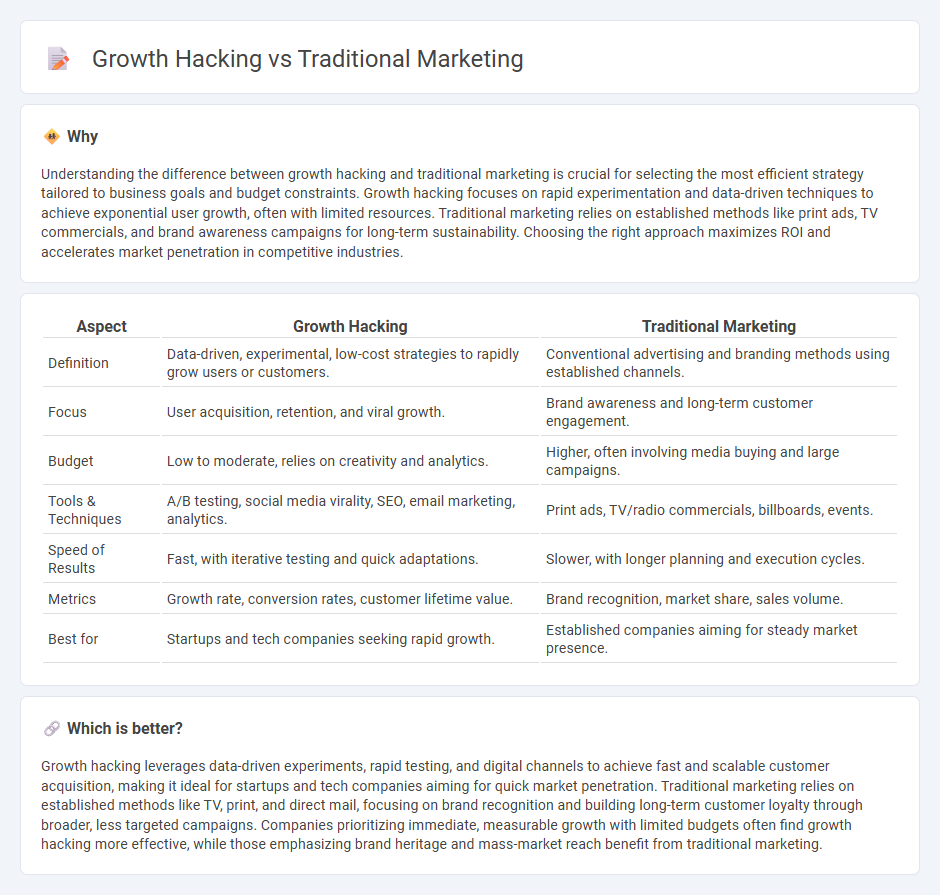
Growth hacking focuses on rapid experimentation across marketing channels and product development to identify the most effective, scalable strategies for growth, often leveraging data analytics and automation tools. Traditional marketing relies on established channels like print, TV, and radio, emphasizing brand awareness and long-term customer engagement through consistent messaging and broad reach. Discover insights into how each approach can amplify your business growth by exploring their key differences.
Why it is important
Understanding the difference between growth hacking and traditional marketing is crucial for selecting the most efficient strategy tailored to business goals and budget constraints. Growth hacking focuses on rapid experimentation and data-driven techniques to achieve exponential user growth, often with limited resources. Traditional marketing relies on established methods like print ads, TV commercials, and brand awareness campaigns for long-term sustainability. Choosing the right approach maximizes ROI and accelerates market penetration in competitive industries.
Comparison Table
| Aspect | Growth Hacking | Traditional Marketing |
|---|---|---|
| Definition | Data-driven, experimental, low-cost strategies to rapidly grow users or customers. | Conventional advertising and branding methods using established channels. |
| Focus | User acquisition, retention, and viral growth. | Brand awareness and long-term customer engagement. |
| Budget | Low to moderate, relies on creativity and analytics. | Higher, often involving media buying and large campaigns. |
| Tools & Techniques | A/B testing, social media virality, SEO, email marketing, analytics. | Print ads, TV/radio commercials, billboards, events. |
| Speed of Results | Fast, with iterative testing and quick adaptations. | Slower, with longer planning and execution cycles. |
| Metrics | Growth rate, conversion rates, customer lifetime value. | Brand recognition, market share, sales volume. |
| Best for | Startups and tech companies seeking rapid growth. | Established companies aiming for steady market presence. |
Which is better?
Growth hacking leverages data-driven experiments, rapid testing, and digital channels to achieve fast and scalable customer acquisition, making it ideal for startups and tech companies aiming for quick market penetration. Traditional marketing relies on established methods like TV, print, and direct mail, focusing on brand recognition and building long-term customer loyalty through broader, less targeted campaigns. Companies prioritizing immediate, measurable growth with limited budgets often find growth hacking more effective, while those emphasizing brand heritage and mass-market reach benefit from traditional marketing.
Connection
Growth hacking and traditional marketing both focus on boosting brand visibility and customer acquisition, but growth hacking uses rapid experimentation and data-driven strategies to achieve scalable growth. Traditional marketing relies on established channels like TV, radio, and print, emphasizing long-term brand building and consumer trust. Integrating growth hacking techniques with traditional marketing campaigns maximizes reach and efficiency by combining creative innovation with proven advertising methods.
Key Terms
Channels
Traditional marketing relies heavily on established channels such as television, radio, print media, and direct mail to reach broad audiences through paid advertisements. Growth hacking prioritizes digital channels like social media platforms, email campaigns, SEO, and viral content to drive rapid, scalable user acquisition with minimal budget. Explore deeper insights into how these channel strategies impact brand growth and engagement.
Experimentation
Traditional marketing relies on established strategies such as brand promotion, mass advertising, and consumer segmentation to drive sales. Growth hacking emphasizes rapid experimentation across channels like social media, email, and product features to identify scalable growth opportunities quickly. Explore more to understand how experimentation transforms growth dynamics in business.
ROI
Traditional marketing relies on established channels like TV, print, and radio to build brand awareness, often requiring significant upfront investment and longer timelines to observe return on investment (ROI). Growth hacking leverages data-driven experimentation and digital tools, such as social media analytics and A/B testing, to rapidly optimize campaigns and maximize ROI with minimal expenditure. Explore innovative strategies to compare the ROI impact of traditional marketing and growth hacking methods effectively.
Source and External Links
Traditional Marketing: Definition, Types and Examples - Traditional marketing uses offline channels like print, broadcast, direct mail, and outdoor advertising to promote products or services to a broad audience, often focusing on building brand recognition through mass media exposure.
Traditional Marketing: Meaning, Importance, Channels, Advantages and Disadvantages - This approach relies on tangible, offline materials such as newspapers, radio, television, billboards, and in-person interactions to reach consumers, especially those not active online, and is valued for its reliability and ability to foster credibility.
What Is Traditional Marketing? (Plus Types, Pros and Cons) - Traditional marketing targets audiences through physical advertisements like billboards, handouts, TV and radio commercials, and direct mail, making it effective for local outreach and connecting with people who spend less time on digital devices.
 dowidth.com
dowidth.com